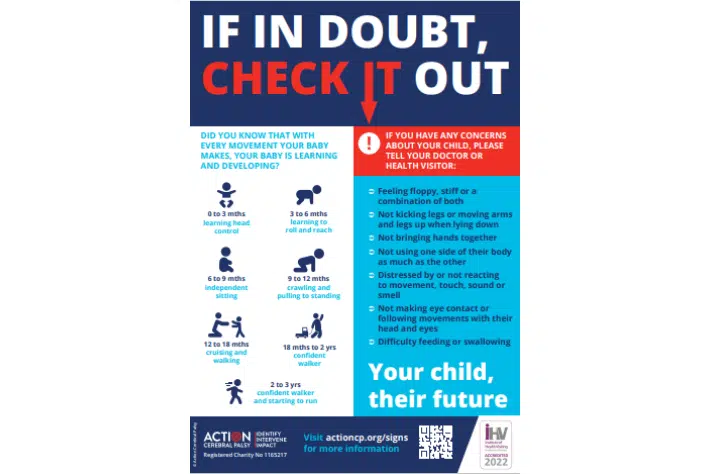7th October 2024
In support of World Cerebral Palsy Day (6 October), we are delighted to share this Voices blog by Pilar Cloud, CEO at Action Cerebral Palsy. Pilar raises the important role of health visitors in the early identification and intervention for those children at risk of cerebral palsy.

Yesterday was World Cerebral Palsy Day, and we are pleased to have this opportunity to shine a light on this complex condition and to work alongside the Institute of Health Visiting (iHV) to raise awareness of the importance of early identification and intervention for those children at risk of cerebral palsy.
What is Cerebral Palsy?
Cerebral palsy (CP) describes a range of movement disorders which can have an impact on many aspects of normal childhood development. CP is a lifelong and fluctuating neurological condition which is the most common cause of physical disability in childhood.
The condition is a result of interference or damage to the developing baby’s central nervous system between conception and 3 years of age. The way in which it affects muscle tone and movement skills will depend on where the damage in the brain has occurred. The initial damage to the brain will not get worse, but its effect on a developing child’s muscular and skeletal systems, and hence motor and functional abilities, may lead to problems with movement and posture as the child grows. It can also interfere with the way the child is able to register and interpret sensory information and physically interact with the environment, communicate, carry out self-care skills and learn from the typical activities of childhood.
There are currently 30,000 children and young people with cerebral palsy living in the UK and a further 130,000 adults with the condition. Roughly, one in every 400 babies born will be diagnosed with cerebral palsy.
Understanding Early Motor Development
With every movement that a baby makes, they are learning and developing. Early motor development impacts a child’s language, cognition, social, emotional and behavioural development. Understanding how each baby or toddler is developing and what they should be doing at each age and stage is important, as this provides practitioners with the underpinning knowledge needed to spot atypical development when it occurs.
Between birth and 3 years of age, babies’ brains develop and grow very rapidly – more than at any other stage in life. As a baby moves, they are experiencing and learning about the world around them. So it is very important that, if they are having problems with motor skills, they get expert help as soon as possible to minimise the impact on their learning and overall development. Every child is unique and develops at different rates, but seeking early help will also enable parents to get the support and help they need which will benefit the wellbeing of the whole family.
If In Doubt, Check It Out
Childhood matters because it is short. Being able to spot the early warning signs is vital to ensure that very young children are identified, assessed and receive the timely intervention they need. The key signs that you should seek professional advice are:
- Baby is late in reaching motor developmental milestones such as sitting by 8 months or walking by 18 months.
- Baby feels floppy, stiff or a combination of these.
- Baby is not bringing his or her hands together.
- Baby is not kicking their legs or moving their arms and legs up when lying down.
- Baby is not using one side of their body as much as the other.
- Baby is distressed by or not reacting to movement, touch, sound or smell.
- Baby is not making eye contact or following movements with their head and eyes.
- Baby is having difficulty feeding or swallowing.
If you or a parent has any concerns about a child’s motor development, please encourage them to speak with their GP to have this checked out.
Due to health visitors’ unique role in reaching all families with children under 5 years old – offering development reviews during this period – they are ideally placed to support families where there may be concerns about motor development. To support health visitors and their teams with this, the iHV has been funded by Novartis to create a Motor Development Toolkit, in partnership with Action Cerebral Palsy and key stakeholders. The resource will be launched later this year and provides an important toolkit to support health visitors and their teams to understand typical motor development for babies and children at each age and stage, as well as highlighting key warning signs of when to worry. There will also be information and advice on what to do with concerns and how to support families.
“Health visitors are a highly skilled workforce and are well-equipped to work in partnership with parents and communities to improve early identification and intervention for infants with cerebral palsy via their role in the Healthy Child Programme. The health visiting service also provides a vital safety net for vulnerable babies and families and is an integral tool in improving outcomes.” – Early Identification, Intervention and Pathways Care for Infants and Young Children with Cerebral Palsy All Party Parliamentary Group Report (2021).
Since 2013, Action Cerebral Palsy (Registered charity no. 1165217) has worked to improve public, professional and political awareness of cerebral palsy and the issues facing children and young people with CP along with their families. We are pleased to have been able to support the iHV in the development of this Motor Development Toolkit.
For more information:
www.actioncp.org
www.actioncp.org/signs


